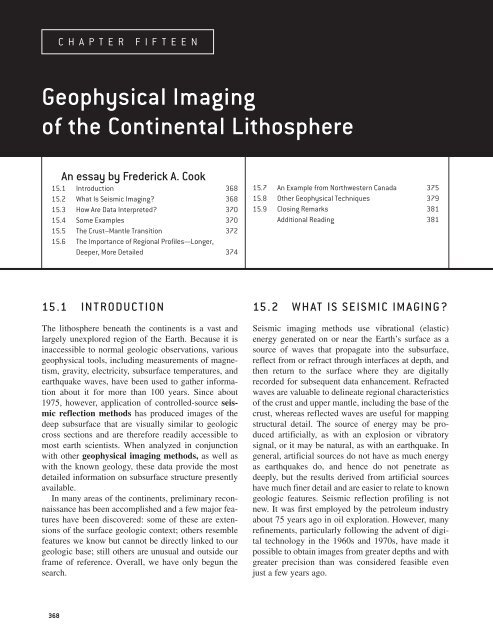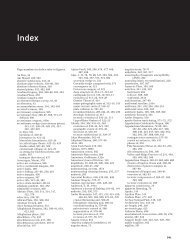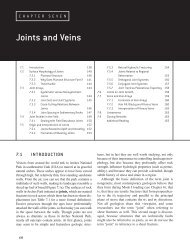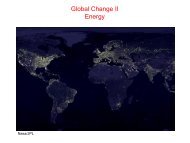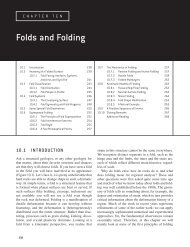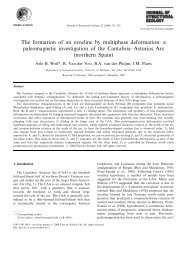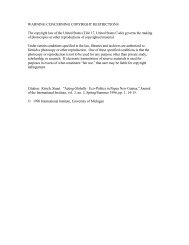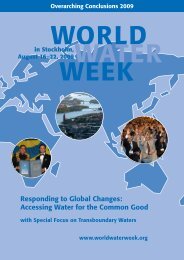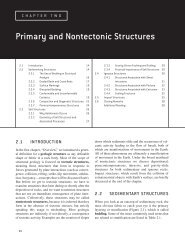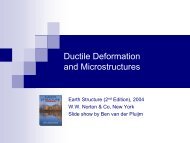Geophysical Imaging of the Continental Lithosphere - Global Change
Geophysical Imaging of the Continental Lithosphere - Global Change
Geophysical Imaging of the Continental Lithosphere - Global Change
- No tags were found...
Create successful ePaper yourself
Turn your PDF publications into a flip-book with our unique Google optimized e-Paper software.
2917-CH15.pdf 11/20/03 5:19 PM Page 368C H A P T E R F I F T E E N<strong>Geophysical</strong> <strong>Imaging</strong><strong>of</strong> <strong>the</strong> <strong>Continental</strong> <strong>Lithosphere</strong>An essay by Frederick A. Cook15.1 Introduction 36815.2 What Is Seismic <strong>Imaging</strong>? 36815.3 How Are Data Interpreted? 37015.4 Some Examples 37015.5 The Crust–Mantle Transition 37215.6 The Importance <strong>of</strong> Regional Pr<strong>of</strong>iles—Longer,Deeper, More Detailed 37415.7 An Example from Northwestern Canada 37515.8 O<strong>the</strong>r <strong>Geophysical</strong> Techniques 37915.9 Closing Remarks 381Additional Reading 38115.1 INTRODUCTIONThe lithosphere beneath <strong>the</strong> continents is a vast andlargely unexplored region <strong>of</strong> <strong>the</strong> Earth. Because it isinaccessible to normal geologic observations, variousgeophysical tools, including measurements <strong>of</strong> magnetism,gravity, electricity, subsurface temperatures, andearthquake waves, have been used to ga<strong>the</strong>r informationabout it for more than 100 years. Since about1975, however, application <strong>of</strong> controlled-source seismicreflection methods has produced images <strong>of</strong> <strong>the</strong>deep subsurface that are visually similar to geologiccross sections and are <strong>the</strong>refore readily accessible tomost earth scientists. When analyzed in conjunctionwith o<strong>the</strong>r geophysical imaging methods, as well aswith <strong>the</strong> known geology, <strong>the</strong>se data provide <strong>the</strong> mostdetailed information on subsurface structure presentlyavailable.In many areas <strong>of</strong> <strong>the</strong> continents, preliminary reconnaissancehas been accomplished and a few major featureshave been discovered: some <strong>of</strong> <strong>the</strong>se are extensions<strong>of</strong> <strong>the</strong> surface geologic context; o<strong>the</strong>rs resemblefeatures we know but cannot be directly linked to ourgeologic base; still o<strong>the</strong>rs are unusual and outside ourframe <strong>of</strong> reference. Overall, we have only begun <strong>the</strong>search.15.2 WHAT IS SEISMIC IMAGING?Seismic imaging methods use vibrational (elastic)energy generated on or near <strong>the</strong> Earth’s surface as asource <strong>of</strong> waves that propagate into <strong>the</strong> subsurface,reflect from or refract through interfaces at depth, and<strong>the</strong>n return to <strong>the</strong> surface where <strong>the</strong>y are digitallyrecorded for subsequent data enhancement. Refractedwaves are valuable to delineate regional characteristics<strong>of</strong> <strong>the</strong> crust and upper mantle, including <strong>the</strong> base <strong>of</strong> <strong>the</strong>crust, whereas reflected waves are useful for mappingstructural detail. The source <strong>of</strong> energy may be producedartificially, as with an explosion or vibratorysignal, or it may be natural, as with an earthquake. Ingeneral, artificial sources do not have as much energyas earthquakes do, and hence do not penetrate asdeeply, but <strong>the</strong> results derived from artificial sourceshave much finer detail and are easier to relate to knowngeologic features. Seismic reflection pr<strong>of</strong>iling is notnew. It was first employed by <strong>the</strong> petroleum industryabout 75 years ago in oil exploration. However, manyrefinements, particularly following <strong>the</strong> advent <strong>of</strong> digitaltechnology in <strong>the</strong> 1960s and 1970s, have made itpossible to obtain images from greater depths and withgreater precision than was considered feasible evenjust a few years ago.368
2917-CH15.pdf 11/20/03 5:19 PM Page 370<strong>the</strong> transit time by a factor <strong>of</strong> 6.0. In this conversion atransit time <strong>of</strong> 5.0 s corresponds to a depth <strong>of</strong> about15.0 km. Below <strong>the</strong> Mohorovičić discontinuity, <strong>the</strong>seismic wave velocity increases to about 8.0 km/s.15.3 HOW ARE DATAINTERPRETED?Great strides have been made in using seismic reflectionpr<strong>of</strong>iling for mapping <strong>the</strong> internal structure <strong>of</strong> <strong>the</strong> lithosphere.Reflections from <strong>the</strong> deep crust (to a depth <strong>of</strong>about 30–40 km) were considered curiosities until <strong>the</strong>1970s; reflections from <strong>the</strong> subcrustal lithosphere totwice this depth, or even more, are not unusual now.However, with technological advancements and <strong>the</strong>resulting improvements in signal quality and imagedepth, <strong>the</strong> challenges to interpretations have been great,because, as we obtain images from structures that are farremoved from our geologic reference on <strong>the</strong> surface, <strong>the</strong>ability to relate <strong>the</strong>m to what we know is increasinglylimited. In many cases, ancillary geophysical methodsthat respond to different physical properties may behelpful in limiting possible interpretations, because <strong>the</strong>seismic images provide a geometric framework <strong>of</strong> structuresthat are found at many scales in <strong>the</strong> lithosphere.Interpretation <strong>of</strong> <strong>the</strong> resultant seismic sections is inmany ways analogous to interpreting a geologic crosssection; indeed, <strong>the</strong> goal <strong>of</strong> <strong>the</strong> data processing is toprovide an image that closely approximates a geologiccross section. However, careful interpretations requireextensive knowledge <strong>of</strong> seismic wave propagation inrocks, geologic principles, and <strong>the</strong> regional geologicand geophysical context. Interpretation is <strong>of</strong>ten an iterativeprocess: new images <strong>of</strong> subsurface geometryfrom <strong>the</strong> reflection pr<strong>of</strong>iles commonly spawn new geologic(or o<strong>the</strong>r geophysical) projects to test some <strong>of</strong> <strong>the</strong>ideas. Data resulting from <strong>the</strong>se projects can <strong>the</strong>n beused to review and <strong>of</strong>ten reinterpret <strong>the</strong> subsurfaceimages. It is not unusual to rework data that may be 10or 15 years old as new data processing techniques andnew geologic information become available.Although this essay is not intended to provide acomplete review <strong>of</strong> image types or all major discoveries,it is helpful to consider images <strong>of</strong> a variety <strong>of</strong>common geologic features.15.4 SOME EXAMPLESMany <strong>of</strong> <strong>the</strong> criteria that are commonly used to identifyfaults in layered sedimentary rocks are not applicablein most crystalline rocks. For example, in layeredstrata, faults are usually delineated by <strong>of</strong>fset layers,whereas reflections from a fault plane are rare. In generallyunlayered crystalline rocks, however, <strong>of</strong>fsets aredifficult to observe (because it is not easy to correlatefrom one side <strong>of</strong> a fault to <strong>the</strong> o<strong>the</strong>r) and reflectionsfrom fault planes or fault zones are common.In Figure 15.2a, for example, prominent layeredreflections from Precambrian sills outline an anticline,<strong>the</strong> right (east) side <strong>of</strong> which is faulted by a westdippingnormal fault, <strong>the</strong> Rocky Mountain Trench insouthwestern Canada. In this case prominent layeringcan be correlated across <strong>the</strong> fault to provide some estimate<strong>of</strong> <strong>the</strong> type (listric normal) and amount <strong>of</strong> displacement(about 10 km) along <strong>the</strong> fault. On <strong>the</strong> o<strong>the</strong>rhand, in Figure 15.2b reflections are visible from <strong>the</strong>Wind River fault zone in western Wyoming. Near <strong>the</strong>surface (to about 4 s travel time, or about 12 kmdepth), Precambrian crystalline rocks on <strong>the</strong> east arethrust westward over sedimentary strata <strong>of</strong> <strong>the</strong> GreenRiver Basin on <strong>the</strong> west. Accordingly, <strong>the</strong> seismicvelocity contrast between <strong>the</strong> crystalline rocks and <strong>the</strong>sediments is quite large, and a prominent reflectionfrom <strong>the</strong> boundary is produced. The Wind River Thrustcan <strong>the</strong>n be followed as a series <strong>of</strong> subparallel reflectionsthat downdip eastward to more than 7.0 s traveltime (about 21 km depth).Here <strong>the</strong>n is a dilemma. If <strong>the</strong> contrast between <strong>the</strong>sedimentary rocks <strong>of</strong> <strong>the</strong> Green River Basin and <strong>the</strong>overlying crystalline rocks <strong>of</strong> <strong>the</strong> Wind River uplift iswhat produces <strong>the</strong> reflection along <strong>the</strong> shallow portion<strong>of</strong> <strong>the</strong> fault, <strong>the</strong>n what is <strong>the</strong> cause <strong>of</strong> <strong>the</strong> reflection atgreater depths where crystalline rocks are juxtaposedwith crystalline rocks? Although this is discussed laterin more detail, <strong>the</strong> answer in this case appears to bethat <strong>the</strong> reflections are cause by mylonitic rocks thatwere formed as a result <strong>of</strong> <strong>the</strong> faulting. The process <strong>of</strong>mylonitization causes a very strong preferred orientation<strong>of</strong> crystals that, in turn, produces a contrast with<strong>the</strong> more randomly oriented crystals above and below.Thus, even where crystalline rocks are seismicallyhomogeneous, <strong>the</strong> faulting process may produce surfacesthat appear as subparallel reflections, particularlyif faulting occurs below <strong>the</strong> brittle–plastic transition.Seismic reflections from relatively homogeneousigneous rocks (e.g., plutons, basalt flows) are generallynot easily observed. Exceptions are rocks that aredeformed so that reflections may arise from <strong>the</strong> deformationsurfaces (as described above for <strong>the</strong> Wind Riveruplift), and igneous intrusions (e.g., sills) that are sufficientlythin that <strong>the</strong>re is a measurable contrast withsurrounding rocks such as sediments or o<strong>the</strong>r crystallinerocks (Figure 15.2c).370 GEOPHYSICAL IMAGING OF THE CONTINENTAL LITHOSPHERE
2917-CH15.pdf 11/20/03 5:19 PM Page 371(a)(b)(c)FIGURE 15.2 (a) Seismic reflection pr<strong>of</strong>ile across <strong>the</strong> sou<strong>the</strong>rn Rocky Mountain Trench near <strong>the</strong> Canada-U.S. border. Note that <strong>the</strong>prominent layering, which is drilled on <strong>the</strong> west and is known to be dominantly Proterozoic sills, is <strong>of</strong>fset along a west-dipping listricnormal fault that has about 10 km <strong>of</strong> dip-slip displacement. Data were recorded by Duncan Energy <strong>of</strong> Denver, Colorado. (b) Seismicpr<strong>of</strong>ile from <strong>the</strong> Wind River Mountains in Wyoming (USA). The Wind River fault juxtaposes crystalline rocks <strong>of</strong> <strong>the</strong> Wind River Mountainswith sedimentary rocks <strong>of</strong> <strong>the</strong> Green River Basin along a moderately east-dipping fault, and this provides a simple explanation for <strong>the</strong>prominent reflection. Below a travel time <strong>of</strong> about 3.5–4.0 s, however, <strong>the</strong> fault zone places crystalline rocks onto crystalline rocks and<strong>the</strong> reflections must be caused by o<strong>the</strong>r mechanisms. Data recorded by COCORP (Consortium for <strong>Continental</strong> Reflection Pr<strong>of</strong>iling) in1977. (c) Seismic pr<strong>of</strong>ile from <strong>the</strong> Proterozoic Trans-Hudson Orogen in nor<strong>the</strong>rn Saskatchewan (Canada) illustrating prominentsubhorizontal reflections that have been interpreted as intrusive rocks. Note that <strong>the</strong> reflector appears to cross cut several dippingreflections. Note also <strong>the</strong> prominent Moho on <strong>the</strong>se data.15.4 SOME EXAMPLES371
2917-CH15.pdf 11/20/03 5:20 PM Page 37215.5 THE CRUST–MANTLETRANSITIONThe transition from <strong>the</strong> crust to <strong>the</strong> mantle is generallyconsidered to be a relatively simple surface that hasmafic rocks such as gabbro or mafic granulites above,and ultramafic rocks below (see Chapter 14). Indeed,much research in <strong>the</strong> 1950s to 1970s attempted toaddress <strong>the</strong> question <strong>of</strong> whe<strong>the</strong>r <strong>the</strong> transition is a compositionalchange (i.e., gabbro or granulite in <strong>the</strong> crustto peridotite in <strong>the</strong> mantle) or whe<strong>the</strong>r it could be achange in phase (as from mafic granulites in <strong>the</strong> crustto eclogites in <strong>the</strong> mantle). Central to <strong>the</strong> discussionwas <strong>the</strong> observation from regional seismic refraction(a)FIGURE 15.3 Some reflection characteristics <strong>of</strong> <strong>the</strong> crust–mantle transition. (a) Pr<strong>of</strong>ile from south-central portion <strong>of</strong> <strong>the</strong>Canadian Cordillera illustrating a relatively simple, single reflection from near <strong>the</strong> transition. On <strong>the</strong> right side <strong>of</strong> <strong>the</strong> figure, <strong>the</strong>numbers 6.0 and 7.0 represent <strong>the</strong> positions <strong>of</strong> <strong>the</strong> Moho, as identified from adjacent seismic refraction data, for average velocities<strong>of</strong> 6.0 and 7.0 km/s, respectively. RM represents <strong>the</strong> preferred position <strong>of</strong> <strong>the</strong> Moho using <strong>the</strong> crustal velocity structure determinedfrom <strong>the</strong> refraction pr<strong>of</strong>ile.372 GEOPHYSICAL IMAGING OF THE CONTINENTAL LITHOSPHERE(b)
2917-CH15.pdf 11/20/03 5:20 PM Page 373and earthquake data that <strong>the</strong>re is almost always aprominent seismic velocity increase at 40–50 kmbeneath <strong>the</strong> continents and about 10 km beneath <strong>the</strong>oceans. On <strong>the</strong>se grounds, <strong>the</strong> boundary appears to berelatively simple and globally significant, and, as such,is known as <strong>the</strong> Mohorovičić discontinuity, or Moho.As <strong>the</strong> information obtained from reflection pr<strong>of</strong>ilingbecomes increasingly detailed, however, we see that <strong>the</strong>crust–mantle transition is clearly not a uniform boundarybecause lateral variations in its geometry and reflectioncharacteristics are common (Figure 15.3). It can bestructurally complex or simple, multilayered or single(c)(d)FIGURE 15.3 (Continued) Note that <strong>the</strong> Moho appears to be located at <strong>the</strong> base <strong>of</strong> crustal reflectivity, and that <strong>the</strong> underlying mantlehas fewer reflections (e.g., MR). Data were recorded by LITHOPROBE in 1988. (b) Portion <strong>of</strong> a seismic pr<strong>of</strong>ile that illustrates listricstructures into <strong>the</strong> crust–mantle transition. Data were recorded by LITHOPROBE in 1996. This segment is from beneath <strong>the</strong> Great Beararc region on <strong>the</strong> regional pr<strong>of</strong>ile (Figure 15.5). (c) Portion <strong>of</strong> a seismic pr<strong>of</strong>ile that illustrates many lower crustal layers that are parallelto <strong>the</strong> Moho as well as a possible truncation (T?). Data were recorded by LITHOPROBE in 1996. (d) Portion <strong>of</strong> a seismic pr<strong>of</strong>ile fromnor<strong>the</strong>rn Saskatchewan (Canada) that illustrates a local deepening <strong>of</strong> <strong>the</strong> crust–mantle transition (Moho keel). Note that although<strong>the</strong>re is not a prominent reflection near <strong>the</strong> transition, <strong>the</strong> reflectivity does diminish near it. In this figure, two locations for estimates <strong>of</strong>travel time to <strong>the</strong> reflection Moho are indicated from adjacent refraction pr<strong>of</strong>iles.15.5 THE CRUST–MANTLE TRANSITION373
2917-CH15.pdf 11/20/03 5:20 PM Page 374surface, flat or dipping; and any <strong>of</strong> <strong>the</strong>se variations maybe present along a single pr<strong>of</strong>ile, sometimes changingover distances <strong>of</strong> only a few kilometers.On <strong>the</strong> o<strong>the</strong>r hand, one <strong>of</strong> <strong>the</strong> most obvious characteristics<strong>of</strong> many reflection pr<strong>of</strong>iles is <strong>the</strong> transitionfrom reflective crust to relatively nonreflective mantle(Figure 15.3). Indeed, this effect is so pervasive on aglobal scale that it is commonly used as a means toidentify <strong>the</strong> crust–mantle transition; <strong>the</strong> “reflectionMoho” is generally interpreted to be at <strong>the</strong> base <strong>of</strong>prominent crustal reflectivity. Thus, on one hand <strong>the</strong>detailed structural and reflection characteristics <strong>of</strong> <strong>the</strong>transition are complex and variable (Figure 15.3),while on <strong>the</strong> o<strong>the</strong>r <strong>the</strong>re are regional, large-scale differencesin <strong>the</strong> reflectivity <strong>of</strong> <strong>the</strong> crust and <strong>the</strong> uppermantle. Until <strong>the</strong> advent <strong>of</strong> crustal reflection pr<strong>of</strong>iling,and particularly high-quality detailed images <strong>of</strong> <strong>the</strong>lower crust and upper mantle, <strong>the</strong>se characteristicswere not observable. As a result, any future interpretation<strong>of</strong> <strong>the</strong> crust–mantle transition must account forgeometric complexities at relatively small scales (kilometersto tens <strong>of</strong> kilometers), and relative uniformitywhen viewed at larger scale with lower resolution. Thismay ultimately be one <strong>of</strong> <strong>the</strong> most fundamental results<strong>of</strong> <strong>the</strong>se kinds <strong>of</strong> data as it will lead to new concepts <strong>of</strong>how <strong>the</strong> crust and mantle interact.One <strong>of</strong> <strong>the</strong> more heated debates in <strong>the</strong> interpretation<strong>of</strong> deep-crustal reflection pr<strong>of</strong>iles has been <strong>the</strong> cause(or causes) <strong>of</strong> reflectivity. Some aspects are wellunderstood. For example, a reflection must resultfrom a change in seismic velocity and/or rock densityand <strong>the</strong> magnitude <strong>of</strong> <strong>the</strong> reflection (amplitude) isrelated to <strong>the</strong> magnitude <strong>of</strong> <strong>the</strong> contrast. Hence, a contrastbetween a rock with relatively low seismic velocity,such as a sandstone, and ano<strong>the</strong>r with a relativelyhigh seismic velocity, such as a gneiss, will produce asubstantial reflection. At great depth, however, seismicvelocities tend to be somewhat more homogenizedthan <strong>the</strong>y are near <strong>the</strong> surface, because microcracksand pores are closed within a few kilometers <strong>of</strong><strong>the</strong> surface, so that differences in seismic velocityfrom one rock type to ano<strong>the</strong>r tend to be diminished.Coupled with <strong>the</strong> fact that boundaries are not <strong>of</strong>teneasily traced to known interfaces at <strong>the</strong> surface or indrill holes, <strong>the</strong> causes <strong>of</strong> deep reflections are notalways clear. They may be from metasedimentaryrocks, mylonite zones, layered intrusions, fluids, orcombinations <strong>of</strong> <strong>the</strong>se.Where such boundaries can be related to knownfeatures, it has been found that any feature in <strong>the</strong> precedinglist may explain <strong>the</strong> reflections, so that withoutsome additional information, it is difficult touniquely identify <strong>the</strong> lithology <strong>of</strong> specific reflectors.Never<strong>the</strong>less, whe<strong>the</strong>r or not geologic causes <strong>of</strong> specificreflectors can be determined, <strong>the</strong> patterns <strong>of</strong>reflectivity provide first-order geometric frameworksfor interpretation.15.6 THE IMPORTANCE OFREGIONAL PROFILES—LONGER, DEEPER, MOREDETAILEDIn order to provide valuable information on <strong>the</strong>regional structure <strong>of</strong> <strong>the</strong> lithosphere, seismic pr<strong>of</strong>ilesmust be hundreds <strong>of</strong> kilometers long. Imagine tryingto look into a dark room through a small hole with <strong>the</strong>illumination on your side <strong>of</strong> <strong>the</strong> hole. As <strong>the</strong> hole isincreased in size, more <strong>of</strong> <strong>the</strong> light can penetratethrough <strong>the</strong> aperture, and more <strong>of</strong> <strong>the</strong> reflected lightfrom <strong>the</strong> objects inside <strong>the</strong> room is <strong>the</strong>n visible from<strong>the</strong> vantage point outside <strong>the</strong> hole. Fur<strong>the</strong>rmore, ashigher energy (brighter) light is used, <strong>the</strong> featureswithin <strong>the</strong> darkened room become more visible. Thesituation is similar with seismic pr<strong>of</strong>iling: as longerpr<strong>of</strong>iles (apertures) are used, large-scale features aremore likely to be seen, and as more energy (truckvibrator sources) is used, <strong>the</strong> input signal is larger, andmore reflections are usually visible. By analogy,<strong>the</strong>refore, long seismic lines with many truck vibratorswill be <strong>the</strong> most beneficial for mapping largestructures <strong>of</strong> <strong>the</strong> lithosphere. Of course, <strong>the</strong>se kinds <strong>of</strong>surveys require efforts that are correspondingly moreexpensive.In addition to long pr<strong>of</strong>iles with large energysources, it is desirable to obtain <strong>the</strong> most detailed geologicinformation possible. In order to accomplish this,<strong>the</strong> signal must include <strong>the</strong> widest possible range <strong>of</strong>frequencies. When much <strong>of</strong> <strong>the</strong> seismic pr<strong>of</strong>iling wasinitiated on regional scales across North America by<strong>the</strong> COCORP (COnsortium for COntinental ReflectionPr<strong>of</strong>iling) project from 1975–1980, technological limitations(long travel time for signals from <strong>the</strong> uppermantle) precluded acquisition <strong>of</strong> deep data with sufficientlyhigh frequencies to provide much detail. Now<strong>the</strong>re are close to 20,000 km that have been recorded inNorth America alone, and over <strong>the</strong> past 20 years technologicaldevelopments have allowed acquisition <strong>of</strong>such extensive and detailed data, <strong>of</strong>ten with remarkableresults. A data set from <strong>the</strong> LITHOPROBE programin Canada serves as an example to illustrate <strong>the</strong>approach to interpretation as well as some <strong>of</strong> <strong>the</strong> informationthat can be obtained.374 GEOPHYSICAL IMAGING OF THE CONTINENTAL LITHOSPHERE
2917-CH15.pdf 11/20/03 5:20 PM Page 37515.7 AN EXAMPLE FROMNORTHWESTERN CANADAA nearly 700-km long pr<strong>of</strong>ile <strong>of</strong> <strong>the</strong> lithosphere innorthwestern Canada recorded in 1996 and processed in1996–1997 was acquired in an effort to map <strong>the</strong> deepstructure <strong>of</strong> <strong>the</strong> western portion <strong>of</strong> <strong>the</strong> Canadian Shield,both where it is exposed on <strong>the</strong> east end <strong>of</strong> <strong>the</strong> pr<strong>of</strong>ileand <strong>the</strong>n where it projects beneath younger sedimentaryrocks <strong>of</strong> <strong>the</strong> Western Canada Sedimentary Basin to <strong>the</strong>west (Figure 15.4). In this region, <strong>the</strong> Canadian Shieldconsists <strong>of</strong> <strong>the</strong> Archean Slave Province on <strong>the</strong> east, andyounger, Proterozoic rocks on <strong>the</strong> west. The Proterozoicrocks are primarily associated with an orogen, <strong>the</strong> WopmayOrogen, that has been interpreted from surface geologicmeasurements to represent remnants <strong>of</strong> tectonicaccretion associated with subduction on <strong>the</strong> west margin<strong>of</strong> <strong>the</strong> Slave craton at about 1.85–2.1 Ga. On <strong>the</strong> west,<strong>the</strong> pr<strong>of</strong>ile ended east <strong>of</strong> <strong>the</strong> Cordillera, although threemore pr<strong>of</strong>iles that cross <strong>the</strong> Cordillera have since beenrecorded to provide nearly 3,000 km <strong>of</strong> data that extendfrom some <strong>of</strong> <strong>the</strong> oldest rocks in <strong>the</strong> world (SlaveProvince) to <strong>the</strong> modern active margin near Alaska.The most dramatic features <strong>of</strong> this pr<strong>of</strong>ile are <strong>the</strong>reflectivity throughout <strong>the</strong> crustal section, <strong>the</strong> regionallysubhorizontal Moho, and <strong>the</strong> extensive, but comparativelysparse, upper mantle reflections (Figure 15.5). It iscommonly observed that <strong>the</strong> crust is more reflective than<strong>the</strong> mantle and this pr<strong>of</strong>ile is a nice illustration. Thismakes sense geologically because <strong>the</strong> crust is lithologicallyheterogeneous at many scales, including scales <strong>of</strong>tens to hundreds <strong>of</strong> meters, in which <strong>the</strong> seismic wavesare most responsive. In contrast, <strong>the</strong> mantle tends to bemore lithologically, and thus seismically, homogeneous.The difficulties <strong>of</strong> interpreting <strong>the</strong> causes <strong>of</strong> crustalreflectivity are, however, amplified for mantle reflectionsbecause (1) mantle reflections cannot be linkeddirectly to outcrop, and (2) <strong>the</strong> relatively homogeneouslithology <strong>of</strong> <strong>the</strong> mantle is not usually expected to havesufficient contrasts in properties to produce reflections.Never<strong>the</strong>less, reflections are present from within <strong>the</strong>mantle, and <strong>the</strong> large lateral extent <strong>of</strong> <strong>the</strong>m implies that<strong>the</strong>y are related to major regional features. Fur<strong>the</strong>rmore,even though <strong>the</strong> large-scale features are visible andmappable along this section, many smaller features,from <strong>the</strong> size <strong>of</strong> a sedimentary basin down to a few hundredmeters, can also be delineated and are, indeed,most helpful in interpreting <strong>the</strong> large-scale structures.It has been suggested that <strong>the</strong> regional patternsalong this pr<strong>of</strong>ile are related to Proterozoic subduction,with East-dipping mantle reflectors as images <strong>of</strong> aremnant subduction zone, and many <strong>of</strong> <strong>the</strong> crustalstructures associated with this subduction and accretionprocess. The ability to image structures at variousFIGURE 15.4 Map <strong>of</strong> northwestern Canada showing <strong>the</strong> division <strong>of</strong> major geologic domains and <strong>the</strong> location <strong>of</strong> a∼700-km long reflection pr<strong>of</strong>ile (prominent dark line). Precambrian domains HO, GB, CN, RA, and TA are all defined on<strong>the</strong> basis <strong>of</strong> regional gravity and magnetic anomaly patterns that can be correlated to outcrops in <strong>the</strong> exposedCanadian Shield to <strong>the</strong> north and east. Domains NH, FS, KW, KS, CH, and BH are entirely covered by <strong>the</strong> sedimentaryrocks <strong>of</strong> <strong>the</strong> Western Canada Sedimentary Basin (gray), <strong>the</strong> eastern edge <strong>of</strong> which is labeled WCSB.15.7 AN EXAMPLE FROM NORTHWESTERN CANADA375
2917-CH15.pdf 11/20/03 5:20 PM Page 376FIGURE 15.5 (upper) Regional seismic pr<strong>of</strong>ile from ancient (>2.6 Ga) rocks <strong>of</strong> <strong>the</strong> SlaveProvince on <strong>the</strong> east, across <strong>the</strong> Proterozoic (2.1–1.85 Ga) Wopmay Orogen in <strong>the</strong> center, and <strong>the</strong>n<strong>the</strong> younger Proterozoic (∼ 1.74–0.55 Ga) Fort Simpson Basin on <strong>the</strong> west. The data are plotted to32.0 s travel time, or about 120 km depth. Note <strong>the</strong> prominent crustal reflectivity, <strong>the</strong>crust–mantle transition, and sparse, but important reflections from within <strong>the</strong> upper mantle(M1 and M2). A general interpretation is shown (lower) to illustrate that <strong>the</strong> accretion <strong>of</strong> <strong>the</strong>Proterozoic rocks to <strong>the</strong> Slave Province probably resulted from subduction, <strong>the</strong> remnants <strong>of</strong> whichare probably <strong>the</strong> dipping mantle reflections.scales fur<strong>the</strong>r allows <strong>the</strong> large and regionally significantboundaries to be related to more local featuresthat, in turn, can be correlated with geologic observations(e.g., outcrop patterns, drill holes, and so on). Forexample, a key factor in <strong>the</strong> interpretation <strong>of</strong> <strong>the</strong> mantlereflections is that <strong>the</strong>y can be followed to structuresin <strong>the</strong> crust that can be approximately dated.Consider <strong>the</strong> relationship between reflections M1(Figure 15.5) and <strong>the</strong> crustal geometry previously discussed.On <strong>the</strong> west (left) side <strong>of</strong> <strong>the</strong> section, a series<strong>of</strong> layers thickens westward between <strong>the</strong> surface and30 km depth (Figure 15.6a). These are almost certainly<strong>the</strong> expression <strong>of</strong> a westward thickening Proterozoicbasin (<strong>the</strong> Fort Simpson Basin). They are overlain byshallow, more or less flat-lying, Paleozoic sedimentaryrocks, and <strong>the</strong>y are underlain by west-dipping surfacesthat can be followed updip eastward to where <strong>the</strong>y subcropat <strong>the</strong> base <strong>of</strong> <strong>the</strong> Paleozoic. Drill holes have intersected<strong>the</strong> crystalline rocks that underlie <strong>the</strong> east flank <strong>of</strong><strong>the</strong> basin and samples dated with radiometric techniquesyield ages <strong>of</strong> about 1.845 Ga. Thus <strong>the</strong> basin layersoverlying <strong>the</strong>se crystalline rocks must be younger thanabout 1.845 Ga, but older than <strong>the</strong> Paleozoic.Within <strong>the</strong> basin, even finer scale structures andstratigraphy may be discerned (Figure 15.6b). Near <strong>the</strong>surface, <strong>the</strong> unconformity between <strong>the</strong> base <strong>of</strong> <strong>the</strong>Paleozoic and <strong>the</strong> Proterozoic is evident as a truncation<strong>of</strong> dipping layers at ∼0.2 s (about 500 m depth). Nearhere, drill holes penetrated from <strong>the</strong> Paleozoic sedimentaryrocks into Proterozoic argillaceous rocks, thusestablishing that <strong>the</strong> uppermost layers <strong>of</strong> <strong>the</strong> Proterozoicare indeed <strong>of</strong> sedimentary origin. Note also that<strong>the</strong> lower Paleozoic layers appear to be arched slightlyinto an anticline at <strong>the</strong> position <strong>of</strong> <strong>the</strong> truncation (Figure15.6b). This anticline must have formed after <strong>the</strong>Paleozoic strata were deposited, and was probablyassociated with <strong>the</strong> uplift <strong>of</strong> <strong>the</strong> Cordillera, <strong>the</strong> easternfront <strong>of</strong> which is located about 50 km west <strong>of</strong> <strong>the</strong> pr<strong>of</strong>ile.At greater reflection times, unconformities are visiblewithin <strong>the</strong> Proterozoic layering, thus indicatingthat <strong>the</strong>se deep layers are indeed also <strong>of</strong> sedimentaryorigin and filled a deep basin during this time (Figure15.6a). Although <strong>the</strong> depth <strong>of</strong> <strong>the</strong> basin is not certain,<strong>the</strong> thickness <strong>of</strong> <strong>the</strong> layering indicates it may be asmuch as 20 km (Figure 15.6a). A prominent reflectioncrosses <strong>the</strong> stratified basin layers at a relatively highangle (Figure 15.6b). Although it is not known withcertainty what this is, because it does not outcrop, itscross-cutting geometry is characteristic <strong>of</strong> dike intrusions,and <strong>the</strong>re are such intrusions known within <strong>the</strong>Proterozoic sedimentary rocks <strong>of</strong> this region.Thus, even though <strong>the</strong>re are no direct observations(drill holes or outcrops) <strong>of</strong> <strong>the</strong> layering to 20 km depth,<strong>the</strong> large-scale geometry <strong>of</strong> a basin shape, <strong>the</strong> geometricrelationships between <strong>the</strong> layers indicating unconformitiesand stratigraphic thickening (Figure 15.6aand b), and regional relationships that indicate Proterozoicsedimentary rocks are very thick to <strong>the</strong> west,376 GEOPHYSICAL IMAGING OF THE CONTINENTAL LITHOSPHERE
2917-CH15.pdf 11/20/03 5:20 PM Page 377(a)(b)(c)FIGURE 15.6 (a) The regional seismic pr<strong>of</strong>ile across <strong>the</strong> Proterozoic basin illustrating <strong>the</strong> huge thickness <strong>of</strong> strata on <strong>the</strong> west and<strong>the</strong> associated shallowing <strong>of</strong> <strong>the</strong> Moho. (b) Enlargement <strong>of</strong> <strong>the</strong> regional pr<strong>of</strong>ile in <strong>the</strong> upper part <strong>of</strong> <strong>the</strong> Proterozoic Fort Simpson Basin on<strong>the</strong> west. Note <strong>the</strong> sedimentary features such as <strong>the</strong> unconformity at <strong>the</strong> base <strong>of</strong> <strong>the</strong> Paleozoic sediments, unconformities in <strong>the</strong>eastward-thinning Proterozoic layers, and <strong>the</strong> prominent cross-cutting reflection that may be an igneous dike. (c) Enlargement <strong>of</strong> <strong>the</strong>regional pr<strong>of</strong>ile across a feature that has been interpreted as <strong>the</strong> remnants <strong>of</strong> an accretionary complex. Note that <strong>the</strong> mantle reflections,M1, can be followed westward where <strong>the</strong>y correlate with <strong>the</strong> Moho and that dipping layers above M1 tend to steepen eastward (upperarrows) as is common in accretionary wedges.15.7 AN EXAMPLE FROM NORTHWESTERN CANADA377
2917-CH15.pdf 11/20/03 5:20 PM Page 378all lead to <strong>the</strong> conclusion that <strong>the</strong> western 100 km or so<strong>of</strong> this pr<strong>of</strong>ile provides an image <strong>of</strong> a large, deep, andpreviously unknown sedimentary basin.Reflections from layered sediments are well knownin petroleum industry exploration. Thus, mapping suchreflections from a large basin, even though it is Proterozoic,are not surprising. However, most <strong>of</strong> <strong>the</strong> deepcontinent includes crystalline metamorphic andigneous rock, and <strong>the</strong> common belief 20 to 25 yearsago was that <strong>the</strong> velocity and density contrasts in <strong>the</strong>serocks were insufficient to produce reflections. If properlyrecorded and processed, however, data from <strong>the</strong>crystalline crust can have reflections that are just asprominent as those from a sedimentary basin.To <strong>the</strong> east <strong>of</strong> <strong>the</strong> sedimentary basin discussed above,<strong>the</strong> crust beneath <strong>the</strong> thin Paleozoic cover consists <strong>of</strong>Proterozoic igneous and metamorphic rocks. This isknown because <strong>the</strong> Paleozoic rocks thin to zero eastward(Figure 15.4), with crystalline rocks exposed on<strong>the</strong> surface east <strong>of</strong> <strong>the</strong>re, and because drill holes intersectPrecambrian crystalline rocks where <strong>the</strong> Paleozoiccover is present. Throughout this region, however,reflections are visible between <strong>the</strong> surface and about35 km depth (Figure 15.5), which must all be within <strong>the</strong>crystalline basement.The complex reflections from <strong>the</strong> crystalline crustcan be interpreted by applying <strong>the</strong> same principles aswith <strong>the</strong> Proterozoic basin: Drill holes provide directevidence for <strong>the</strong> lithology and ages <strong>of</strong> rocks near <strong>the</strong>surface; <strong>the</strong> regional geology is incorporated to <strong>the</strong>extent possible, and detailed geometric relationships(i.e., truncations) are utilized to establish structuralpatterns and age relationships. Although <strong>the</strong>re are toomany details to address <strong>the</strong>m completely here, threeimportant characteristics stand out when <strong>the</strong> reflectionsare interpreted:1. The reflectivity pattern delineates a series <strong>of</strong>complex structures associated with <strong>the</strong> accretion<strong>of</strong> middle Proterozoic rocks to an older Archeancraton (Slave craton).2. These structures are for <strong>the</strong> most part confined to<strong>the</strong> crust.3. The base <strong>of</strong> <strong>the</strong> layering is remarkably abrupt atabout 10–11 s (about 30–33 km) beneath both<strong>the</strong> Proterozoic and <strong>the</strong> Archean regions.The first <strong>of</strong> <strong>the</strong>se is significant because it provideskey evidence on how subduction and accretionoccurred during <strong>the</strong> Proterozoic (about 1.85–2.1 Ga inthis region). From <strong>the</strong> geometric and geologic information,it appears that <strong>the</strong> products (what is visible today)<strong>of</strong> <strong>the</strong> tectonic process acting at that time are nearlyidentical to structures in modern subduction accretionzones. For example, east <strong>of</strong> <strong>the</strong> Fort Simpson Basin andabove <strong>the</strong> mantle subduction reflections, <strong>the</strong> crustalgeometry is nearly identical to that <strong>of</strong> an accretionarywedge and associated structures (Figure 15.6c).The second and third characteristics emphasize <strong>the</strong>apparent structural (or at least reflection) differencesbetween <strong>the</strong> crust and <strong>the</strong> mantle. The base <strong>of</strong> <strong>the</strong>crustal reflectivity (<strong>the</strong> “reflection Moho”) is nearlyhorizontal along most <strong>of</strong> <strong>the</strong> pr<strong>of</strong>ile east <strong>of</strong> <strong>the</strong> FortSimpson Basin and is at a travel time that correspondsto <strong>the</strong> Moho identified from collocated regional seismicrefraction data. This means that <strong>the</strong> crust–mantletransition here is ei<strong>the</strong>r a zone <strong>of</strong> late intrusives (e.g.,sills) that underlies <strong>the</strong> crust, or that it is a structuraldetachment zone. Examination <strong>of</strong> some detailed featureswith travel times near 10–11 s (about 30–33 kmdepth) provides information to distinguish between<strong>the</strong>se possibilities (Figure 15.3b), as many <strong>of</strong> <strong>the</strong> layersin <strong>the</strong> lower crust beneath <strong>the</strong> Great Bear arc (Figure15.5) <strong>of</strong> <strong>the</strong> Wopmay Orogen are listric (flatten)into <strong>the</strong> horizontal reflections near <strong>the</strong> Moho. Thus, <strong>the</strong>crust–mantle transition at this location is almost certainlya structural detachment ra<strong>the</strong>r than a layeredintrusion zone. There are many pr<strong>of</strong>iles around <strong>the</strong>world that have images <strong>of</strong> lower crustal structureslistric into <strong>the</strong> Moho, but <strong>the</strong> data must be <strong>of</strong> sufficientlyhigh quality and have sufficiently fine detail forsuch subtle structures to be observed.At some locations, in contrast to <strong>the</strong> listric structuresjust noted, <strong>the</strong> crust–mantle transition may havecharacteristics appropriate for an interpretation <strong>of</strong> silllikeintrusions; an example is visible beneath <strong>the</strong> SlaveProvince (Figure 15.7). Here, reflections project from<strong>the</strong> lower crust to below <strong>the</strong> Moho, and horizontalreflections at <strong>the</strong> Moho appear to cross cut <strong>the</strong>m.O<strong>the</strong>r characteristics <strong>of</strong> <strong>the</strong> variable crust–mantletransition on this pr<strong>of</strong>ile include <strong>the</strong> following: At twolocations, reflections dip from <strong>the</strong> lower crust into <strong>the</strong>mantle; one <strong>of</strong> <strong>the</strong>se corresponds to <strong>the</strong> interpretedProterozoic subduction zone, and <strong>the</strong> o<strong>the</strong>r is locatedbeneath <strong>the</strong> Archean craton. In some parts <strong>of</strong> <strong>the</strong> pr<strong>of</strong>ile,<strong>the</strong> reflectivity <strong>of</strong> <strong>the</strong> crust–mantle transition isweak or nonexistent; whereas in o<strong>the</strong>rs it is flat andprominent. At some locations <strong>the</strong> reflection Moho isflat, whereas beneath <strong>the</strong> Proterozoic basin it shallowsby a few kilometers (Figure 15.6b). Thus, many <strong>of</strong> <strong>the</strong>variable characteristics <strong>of</strong> <strong>the</strong> crust–mantle transitionthat occur on deep reflection data around <strong>the</strong> world arevisible along this single pr<strong>of</strong>ile over relatively shortlateral distances.378 GEOPHYSICAL IMAGING OF THE CONTINENTAL LITHOSPHERE
2917-CH15.pdf 11/20/03 5:20 PM Page 379FIGURE 15.7 Enlargement <strong>of</strong> a segment <strong>of</strong> <strong>the</strong> regional pr<strong>of</strong>ile from <strong>the</strong> Slave Province(Figure 15.5). Here, <strong>the</strong> Moho appears to have a series <strong>of</strong> dipping surfaces (arrows) that are crosscut by horizontal reflections (RM). One possible interpretation is that <strong>the</strong>se horizontal reflectionsrepresent intrusives.15.8 OTHER GEOPHYSICALTECHNIQUESIntracrustal structures such as <strong>the</strong> Proterozoic basin aresufficiently large to be compared with o<strong>the</strong>r regionaldata. The basin geometry on <strong>the</strong> west is observed onseveral o<strong>the</strong>r seismic pr<strong>of</strong>iles that are parallel to thisone but that are located over a lateral distance <strong>of</strong> morethan 500 km. They can be correlated from one toano<strong>the</strong>r with <strong>the</strong> application <strong>of</strong> o<strong>the</strong>r geophysical data;seismic pr<strong>of</strong>iles provide regional cross sections, but itis <strong>of</strong>ten difficult to project far away from <strong>the</strong> twodimensionalsections without additional information.In many areas, geophysical data such as gravity andmagnetics, can provide such information.The map in Figure 15.8a shows <strong>the</strong> isostatic gravityvariations in northwestern Canada, and Figure 15.8b isan enlargement <strong>of</strong> <strong>the</strong> central portion <strong>of</strong> <strong>the</strong> map in <strong>the</strong>vicinity <strong>of</strong> <strong>the</strong> regional seismic pr<strong>of</strong>ile. To produce thismap, known characteristics <strong>of</strong> <strong>the</strong> Earth’s shape ando<strong>the</strong>r effects have been estimated and removed from<strong>the</strong> measured values. The residual values, or anomalies,were contoured, and ideally represent variationsdue to rocks in <strong>the</strong> near subsurface. The contoured valueswere <strong>the</strong>n plotted as a pseudotopographic image.As gravity anomalies result from variations in rockmass, in principle we should be able to determine <strong>the</strong>relative positions <strong>of</strong> different masses at depth. In practice,however, <strong>the</strong>re is a fundamental problem underlying<strong>the</strong> interpretations <strong>of</strong> <strong>the</strong>se results, as well as o<strong>the</strong>rgeophysical anomalies such as magnetics. Becausenei<strong>the</strong>r <strong>the</strong> subsurface structure nor <strong>the</strong> values <strong>of</strong> mass(or magnetism in <strong>the</strong> case <strong>of</strong> magnetic anomalies) <strong>of</strong><strong>the</strong> rocks is known, an anomaly may be caused bysmall regions with large contrasts in properties, or15.8 OTHER GEOPHYSICAL TECHNIQUES379
2917-CH15.pdf 11/20/03 5:21 PM Page 380large regions with small contrasts in properties. Thereare some limits (spatially), <strong>of</strong> course, because <strong>the</strong>anomalies are located according to map position (e.g.,anomaly FS in Figure 15.8b must be due to somethingin <strong>the</strong> subsurface beneath it), but it is difficult to determinemuch more detail without some additional informationfrom o<strong>the</strong>r techniques.In <strong>the</strong> context <strong>of</strong> regional variations <strong>of</strong> continentalstructure, however, <strong>the</strong> patterns <strong>of</strong> large-scale anomaliescan be extremely valuable in delineating patterns<strong>of</strong> continental structures. For example, in Figure 15.8a,<strong>the</strong> gravity patterns exhibit prominent, but relativelysubdued, anomalies in <strong>the</strong> eastern part <strong>of</strong> <strong>the</strong> map (FSin Figure 15.8b); and more random and higherfrequency patterns in <strong>the</strong> west, which are crossed bysome major northwest oriented features (TT in Figure15.8a). This change occurs where <strong>the</strong> sedimentaryrocks <strong>of</strong> <strong>the</strong> Western Canada Sedimentary Basin giveway to <strong>the</strong> complexly deformed rocks <strong>of</strong> <strong>the</strong> MackenzieMountains in <strong>the</strong> nor<strong>the</strong>rn Cordillera. It is logicalto interpret <strong>the</strong> change in gravity anomalies as beingrelated to <strong>the</strong> large-scale geologic transition from <strong>the</strong>basin to <strong>the</strong> Cordillera.On <strong>the</strong> o<strong>the</strong>r hand, <strong>the</strong> causes <strong>of</strong> <strong>the</strong> patterns beneath<strong>the</strong> Western Canada Basin are less clear. In this area,<strong>the</strong> sedimentary rocks are relatively flat and thin (Figure15.6a), hence <strong>the</strong>y should not exhibit major changesin gravity signature. The observed gravity variations(a)(b)FIGURE 15.8 (a) Isostatic gravity map <strong>of</strong>northwestern Canada plotted with shaded relief(artificial illumination from <strong>the</strong> west, view toward<strong>the</strong> nor<strong>the</strong>ast). The position <strong>of</strong> <strong>the</strong> regional seismicpr<strong>of</strong>ile is shown by <strong>the</strong> thick white line. TTrepresents <strong>the</strong> Tintina Fault, a late strike-slip faultwithin <strong>the</strong> Cordillera, and FS represents <strong>the</strong> FortSimpson Trend associated with <strong>the</strong> Fort SimpsonBasin. The gridded digital gravity data were providedby <strong>the</strong> Canadian <strong>Geophysical</strong> Data Centre, and <strong>the</strong>original version <strong>of</strong> this figure was made by KevinHall. (b) Enlargement <strong>of</strong> <strong>the</strong> map in <strong>the</strong> vicinity <strong>of</strong><strong>the</strong> seismic pr<strong>of</strong>ile to emphasize <strong>the</strong> relationship <strong>of</strong><strong>the</strong> pr<strong>of</strong>ile to <strong>the</strong> FS anomaly. The smaller white linenear <strong>the</strong> bottom right is <strong>the</strong> location <strong>of</strong> a secondpr<strong>of</strong>ile across <strong>the</strong> sou<strong>the</strong>rn portion <strong>of</strong> <strong>the</strong> FS trend,and <strong>the</strong> white circles represent locations <strong>of</strong> drillholes that penetrated crystalline rocks below <strong>the</strong>Western Canada Sedimentary Basin strata.380 GEOPHYSICAL IMAGING OF THE CONTINENTAL LITHOSPHERE
2917-CH15.pdf 11/20/03 5:21 PM Page 381must <strong>the</strong>refore be associated with structure and lithologybeneath <strong>the</strong> sedimentary basin, such as <strong>the</strong> largescalestructures observed on <strong>the</strong> reflection pr<strong>of</strong>ile.The interpretation <strong>of</strong> <strong>the</strong>se observations is facilitatedby <strong>the</strong> fact that <strong>the</strong> anomalies can be followed eastwardinto <strong>the</strong> Canadian Shield, where <strong>the</strong>y are correlatedwith regional structures on <strong>the</strong> surface in <strong>the</strong> ancient(1.8–3.5 Ga) rocks. Accordingly, <strong>the</strong> patterns observedin <strong>the</strong> basin provide an image <strong>of</strong> structural patterns thatproject westward from <strong>the</strong> Canadian Shield, beneath<strong>the</strong> basin, to <strong>the</strong> eastern part <strong>of</strong> <strong>the</strong> Cordillera. Thus,while this approach does not necessarily provide uswith much detail on <strong>the</strong> nature <strong>of</strong> <strong>the</strong> causes <strong>of</strong> individualanomalies, it does provide important information on<strong>the</strong> orientation and extent <strong>of</strong> subsurface structures in aregion where <strong>the</strong>re are no exposures.All <strong>of</strong> <strong>the</strong> o<strong>the</strong>r seismic pr<strong>of</strong>iles that cross anomalyFS (Figure 15.8b) have essentially <strong>the</strong> same geometry;<strong>the</strong> Proterozoic basin previously described occurseverywhere to <strong>the</strong> west <strong>of</strong> FS. In all locations, <strong>the</strong> gravitysignature indicates that <strong>the</strong> rocks at depth (below<strong>the</strong> Paleozoic sediments) are low density west <strong>of</strong> FSbecause <strong>the</strong> gravity anomalies are low, and this informationis consistent with a deep, but old, basin within<strong>the</strong> crust. In applications for regional crustal andlithospheric imaging, <strong>the</strong>refore, one <strong>of</strong> <strong>the</strong> most valuablecontributions <strong>of</strong> potential field maps is to projectinformation over long distances away from <strong>the</strong> muchhigher resolution seismic cross sections.15.9 CLOSING REMARKS<strong>Geophysical</strong> imaging techniques have become standardtools for mapping <strong>the</strong> subsurface structure <strong>of</strong> <strong>the</strong>continental lithosphere. The most successful resultsderive from seismic reflection data that can be linkedto known geologic features, ei<strong>the</strong>r in outcrop or in drillholes. Improvements in field acquisition methods andsignal processing have led to remarkable images <strong>of</strong> <strong>the</strong>crust and mantle lithosphere. Thus, as more, longer,and increasingly detailed pr<strong>of</strong>iles are acquired, <strong>the</strong>ability to compare, contrast, and link <strong>the</strong> results witho<strong>the</strong>r geologic and geophysical data will continue t<strong>of</strong>oster new concepts on <strong>the</strong> origin and tectonic development<strong>of</strong> <strong>the</strong> continental lithosphere.ADDITIONAL READINGCook, F., van der Velden, A., Hall, K., and Roberts, B,1999. Frozen subduction in Canada’s Northwest Territories:lithoprobe deep lithospheric reflection pr<strong>of</strong>iling<strong>of</strong> <strong>the</strong> western Canadian Shield. Tectonics, 18, 1–24.Lucas, S., Green, A., Hajnal, Z., White, D., Lewry, J.,Ashton, K., Weber, W., and Clowes, R., 1993. Deepseismic pr<strong>of</strong>ile <strong>of</strong> a Proterozoic collision zone: surprisesat depth. Nature, 363, 339–342.Mandler, H., and Clowes, R., 1997. Evidence forextensive tabular intrusions in <strong>the</strong> Precambrianshield <strong>of</strong> western Canada: a 160-km long sequence<strong>of</strong> bright reflections. Geology, 25, 271–274.Smithson, S., Brewer, J., Kaufman, S., Oliver, J., andHurich, C., 1978. Nature <strong>of</strong> <strong>the</strong> Wind River thrust,Wyoming, from COCORP deep reflection data andfrom gravity data. Geology, 6, 648–652.van der Velden, A., and Cook, F., 1996. Structure andtectonic development <strong>of</strong> <strong>the</strong> sou<strong>the</strong>rn Rocky Mountaintrench. Tectonics, 15, 517–544.van der Velden, A., and Cook, F., 1999. Proterozoicand Cenozoic subduction complexes: a comparison<strong>of</strong> geometric features. Tectonics, 18, 575–581.ADDITIONAL READING381


